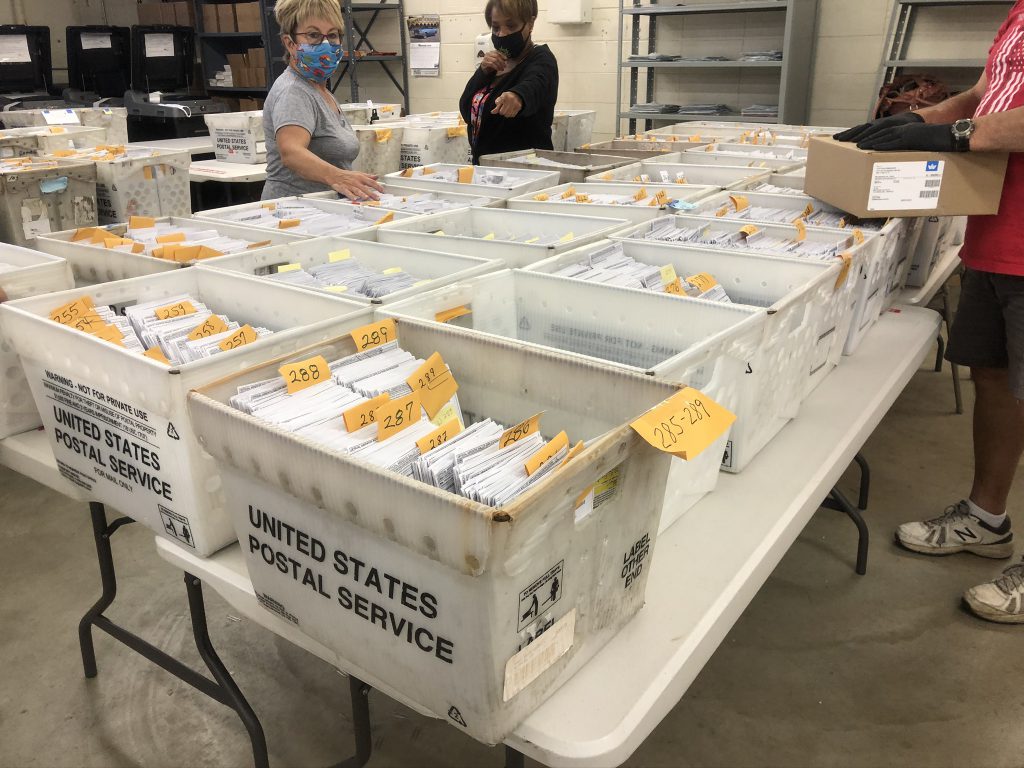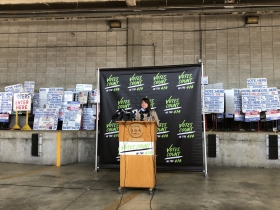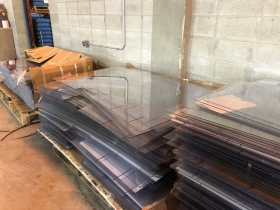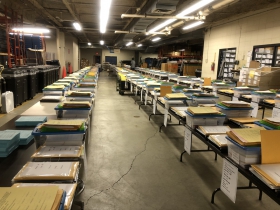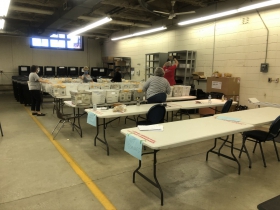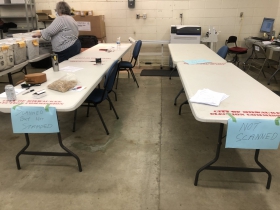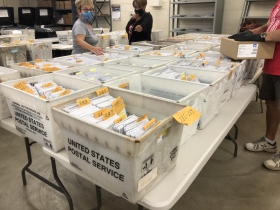Inside Milwaukee’s Election Preparation Effort
Election Commission shows off voting equipment, ballot prep and other intricacies.
“Voting in Milwaukee is as easy as one, two, three,” said Milwaukee Election Commission executive director Claire Woodall-Vogg in announcing the city’s “Votes Count in the 414” campaign.
But while voting absentee by mail and voting in-person early or on election day all might be easy to do, the effort to support over 200,000 people doing this is a lot harder.
“There are hundreds of hours of work that into preparation for elections,” said Mayor Tom Barrett. If you count that just by staff time, it’s possible hundreds of hours every day go into getting ready for the election.
Barrett and Woodall-Vogg spoke from a podium in front of the loading docks at the election commission warehouse at 1901 S. Kinnickinnic Ave. The unassuming building at the south end of Walker’s Point is where all the city’s ballots originate, and ultimately where they all end up.
Kits have also been prepared for each of the city’s 173 polling places and sit ready for distribution five days in advance of the November 3rd election. They’re surrounded by polling equipment, including 400 plexiglass shields and at least one box of “I Voted” stickers.
To date the city has mailed out over 110,000 ballots and gotten back 40,000, of which an estimated 70 percent have been returned via the 15 drop boxes across the city.
Workers empty the drop boxes in pairs daily, ensuring a witness is present when each sealed bag is removed. The ballots are brought back to the warehouse, where the envelope is checked for the appropriate signatures (that of the voter and a witness). If it is deemed deficient, the city contacts the voter and gives them options for remedying the ballot.
Accepted ballots are sorted by ward, without opening the envelope, and stored in a room that is under 24-hour video surveillance and locked when less than two people are present. Under state law absentee ballot processing can’t begin until polls open on election day.
It’s that law which will prevent the city from having unofficial results until the day after the election.
“We are not anticipating we will have results until the wee hours of the morning on November 4th,” said Woodall-Vogg.
Barrett has been a frequent critic of the law. “You would actually think someone would want the system to fail by designing it that way,” he said. He recently gained at ally in allowing earlier processing in Republican US Senator Ron Johnson.
“We believe it is more efficient, effective and secure to use a central count on election day,” said Woodall-Vogg.
The August primary, which Woodall-Vogg said included a surge of ballots being delivered after 5 p.m., wasn’t completed being tallied until 2:30 a.m. the next day.
Once absentee ballots are received the city must sort ballots into 325 wards and process them through high-speed machines. The latter has been upgraded for the November election, with the city now possessing 12 machines, up from four. The machines aren’t perfect, the ballots must be flat and ballots coming out of envelopes are not. “We have to work to get them flat,” said Woodall-Vogg while demonstrating the machine. “As silly and ridiculous as that sounds, it’s a big problem for us.”
She said voters choosing to vote absentee can help speed up the process by returning their ballot ahead of election day.
And however long it takes to count the ballots, Woodall-Vogg will be there. The current plan calls for three shifts with 350 workers working on the 62,000-square-foot, fourth floor of the building at 501 W. Michigan St. The facility is open to the public for observation, as are polling places, but Woodall-Vogg said the commission is working to live stream the operations at central count for those interested.
The central count workers are part of a force of 4,000 Woodall-Vogg and her deputy Jonatan Zuniga hope to recruit. They have over 3,500 already, with 1,000 having prior election experience. The city needs 2,500 workers, but is recruiting additional workers in anticipation of no shows. The job pays approximately $230.
The current boxes will be acquired by the City Treasurer and then used as secure drop boxes in new locations for city property tax payments.
The city is also bracing for any last-minute election law changes. Woodall-Vogg said she expects more guidance from the Wisconsin Elections Commission, especially related to a federal court decision that would allow ballots to be postmarked by election day and received by November 9th.
Information on voting locations, including early voting and drop boxes, can be found on a new city webpage milwaukee.gov/414votes.
Voters can register to vote, request an absentee ballot, track its mailing status and see if the city has received it back on the state’s My Vote WI website.
Photos
If you think stories like this are important, become a member of Urban Milwaukee and help support real, independent journalism. Plus you get some cool added benefits.
More about the 2020 General Election
- Senator Agard Statement on Senator Knodl’s Continued Relitigation of the 2020 Presidential Election - Dane County Executive Melissa Agard - Aug 29th, 2023
- Report Calls For Criminally Charging State’s Fake Electors - Henry Redman - Dec 19th, 2022
- Vos Withdraws Subpoenas, Ends Gableman Probe - Henry Redman - Aug 30th, 2022
- Judge Blasts Gableman Probe, Deleted Records - Henry Redman - Aug 17th, 2022
- Vos Fires Gableman, Ends Election Probe - Shawn Johnson - Aug 14th, 2022
- Judge Orders Gableman To Pay $163,000 In Legal Fees - Rich Kremer - Aug 2nd, 2022
- Prosecute 2020 Fake Electors, Advocates Demand - Erik Gunn - Aug 1st, 2022
- Trump Calls For Nullification of Wisconsin’s 2020 Election - Henry Redman - Jul 12th, 2022
- Legal Fight Over Gableman Probe Keeps Growing - Shawn Johnson - Jun 30th, 2022
- Back In the News: Fake Elector Scheme Dogs Ron Johnson - Bruce Murphy - Jun 28th, 2022
Read more about 2020 General Election here


